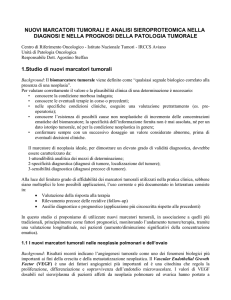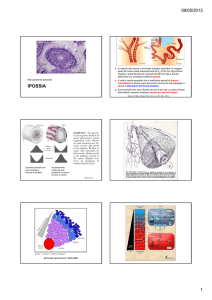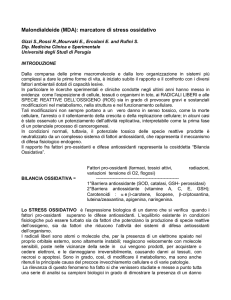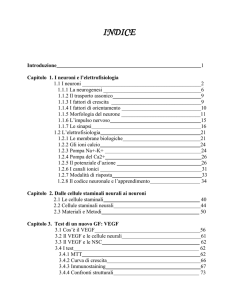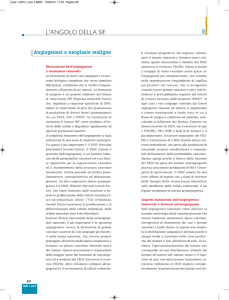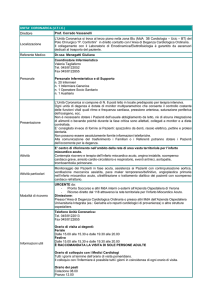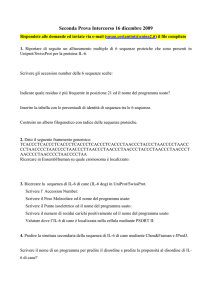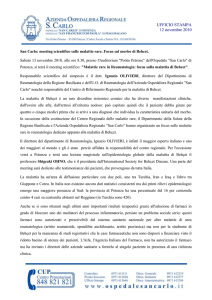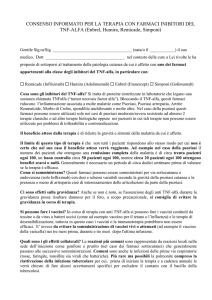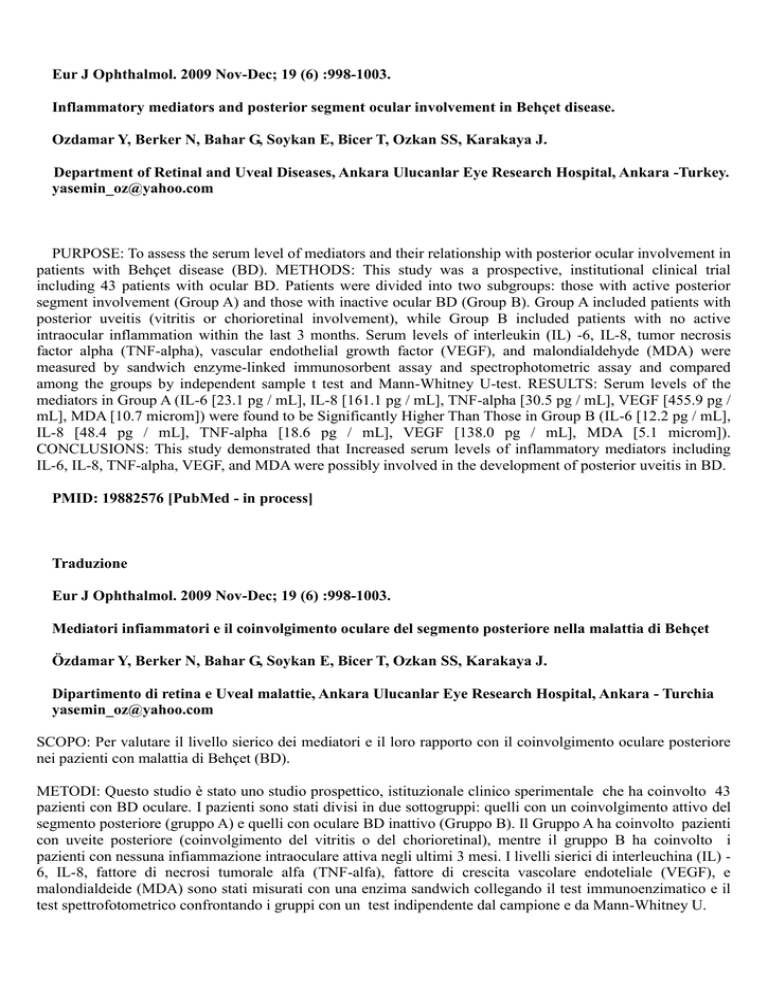
Eur J Ophthalmol. 2009 Nov-Dec; 19 (6) :998-1003.
Inflammatory mediators and posterior segment ocular involvement in Behçet disease.
Ozdamar Y, Berker N, Bahar G, Soykan E, Bicer T, Ozkan SS, Karakaya J.
Department of Retinal and Uveal Diseases, Ankara Ulucanlar Eye Research Hospital, Ankara -Turkey.
[email protected]
PURPOSE: To assess the serum level of mediators and their relationship with posterior ocular involvement in
patients with Behçet disease (BD). METHODS: This study was a prospective, institutional clinical trial
including 43 patients with ocular BD. Patients were divided into two subgroups: those with active posterior
segment involvement (Group A) and those with inactive ocular BD (Group B). Group A included patients with
posterior uveitis (vitritis or chorioretinal involvement), while Group B included patients with no active
intraocular inflammation within the last 3 months. Serum levels of interleukin (IL) -6, IL-8, tumor necrosis
factor alpha (TNF-alpha), vascular endothelial growth factor (VEGF), and malondialdehyde (MDA) were
measured by sandwich enzyme-linked immunosorbent assay and spectrophotometric assay and compared
among the groups by independent sample t test and Mann-Whitney U-test. RESULTS: Serum levels of the
mediators in Group A (IL-6 [23.1 pg / mL], IL-8 [161.1 pg / mL], TNF-alpha [30.5 pg / mL], VEGF [455.9 pg /
mL], MDA [10.7 microm]) were found to be Significantly Higher Than Those in Group B (IL-6 [12.2 pg / mL],
IL-8 [48.4 pg / mL], TNF-alpha [18.6 pg / mL], VEGF [138.0 pg / mL], MDA [5.1 microm]).
CONCLUSIONS: This study demonstrated that Increased serum levels of inflammatory mediators including
IL-6, IL-8, TNF-alpha, VEGF, and MDA were possibly involved in the development of posterior uveitis in BD.
PMID: 19882576 [PubMed - in process]
Traduzione
Eur J Ophthalmol. 2009 Nov-Dec; 19 (6) :998-1003.
Mediatori infiammatori e il coinvolgimento oculare del segmento posteriore nella malattia di Behçet
Özdamar Y, Berker N, Bahar G, Soykan E, Bicer T, Ozkan SS, Karakaya J.
Dipartimento di retina e Uveal malattie, Ankara Ulucanlar Eye Research Hospital, Ankara - Turchia
[email protected]
SCOPO: Per valutare il livello sierico dei mediatori e il loro rapporto con il coinvolgimento oculare posteriore
nei pazienti con malattia di Behçet (BD).
METODI: Questo studio è stato uno studio prospettico, istituzionale clinico sperimentale che ha coinvolto 43
pazienti con BD oculare. I pazienti sono stati divisi in due sottogruppi: quelli con un coinvolgimento attivo del
segmento posteriore (gruppo A) e quelli con oculare BD inattivo (Gruppo B). Il Gruppo A ha coinvolto pazienti
con uveite posteriore (coinvolgimento del vitritis o del chorioretinal), mentre il gruppo B ha coinvolto i
pazienti con nessuna infiammazione intraoculare attiva negli ultimi 3 mesi. I livelli sierici di interleuchina (IL) 6, IL-8, fattore di necrosi tumorale alfa (TNF-alfa), fattore di crescita vascolare endoteliale (VEGF), e
malondialdeide (MDA) sono stati misurati con una enzima sandwich collegando il test immunoenzimatico e il
test spettrofotometrico confrontando i gruppi con un test indipendente dal campione e da Mann-Whitney U.
RISULTATI: I livelli sierici dei mediatori nel gruppo A (IL-6 [23,1 pg / mL], IL-8 [161,1 pg / mL], TNF-alfa
[30,5 pg / mL], VEGF [455,9 pg / mL], MDA [10,7 microM]) sono risultati significativamente più elevati di
quelli nel gruppo B (IL-6 [12,2 pg / mL], IL-8 [48,4 pg / mL], TNF-alfa [18,6 pg / mL], VEGF [138,0 pg / mL],
MDA [5.1 microM]).
CONCLUSIONI: Questo studio ha dimostrato che l’aumento dei livelli sierici dei mediatori infiammatori
compreso IL-6, IL-8, TNF-alfa, VEGF, e MDA sono stati eventualmente coinvolte nello sviluppo di uveite
posteriore in BD.
PMID: 19882576 [PubMed - in process]

